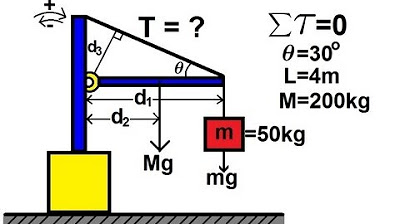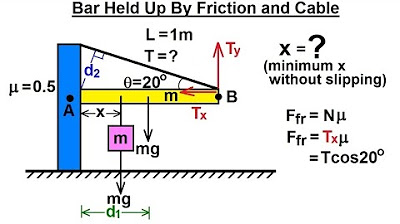Physics 15 Torque (5 of 27) Tension=? Supporting a Gate
TLDRThe video script presents a detailed physics problem involving the concept of torque to find the tension in a cable suspending a gate and the forces at its hinges. The gate, with a mass of 400 Newtons and dimensions of one meter by two meters, is suspended at a 30-degree angle by a cable. The challenge is to calculate the tension in the cable and the vertical and horizontal components of force at the hinges, labeled A and B. The solution involves summing torques around a pivot point, using trigonometric relationships to find perpendicular distances, and applying equilibrium conditions. The process requires finding the perpendicular distance from the line of action of forces to the pivot point, which is key to solving for the tension. The video concludes with the calculation of the tension in the cable as 214 Newtons and the horizontal force at hinge B as 186 Newtons, illustrating a methodical approach to problem-solving in physics.
Takeaways
- 📐 The problem involves a gate suspended by a cable at a 30-degree angle to the horizontal, with two hinges A and B, and a mass causing a weight of 400 Newtons.
- ⚖️ The horizontal force at hinge A is zero, meaning there is no stress at A in the horizontal direction, only vertical.
- 🔍 The goal is to find the tension in the cable and the three components of the forces: the vertical component at A and the horizontal and vertical components at B.
- 🔩 Torques are summed around pivot point B to find the tension in the cable without needing to know the forces at B in the X and Y directions.
- 📏 The perpendicular distance (D) from the line of action of the tension force to the pivot point is found using trigonometry based on the gate's dimensions and the angle of the cable.
- 🧮 The tension in the cable (T) is calculated to be 214 Newtons by equating the torques caused by the gate's weight and the tension force.
- 🔄 To find the force at B in the X direction (F_Bx), the pivot point is moved to A, and torques are summed around A, considering the tension and weight of the gate.
- 🔢 The force at B in the X direction is found to be 186 Newtons after calculating the perpendicular distance (d2) from the line of action of force to the pivot point.
- ⚙️ The sum of the forces in the Y direction equals zero, which is used to find the combined force at A and B in the Y direction, which is 93 Newtons.
- 💡 The problem-solving approach involves using trigonometry to find distances and angles, and then applying these to calculate the forces and tensions involved.
- 📉 A mistake in calculating the sine of 60 degrees was corrected during the process, emphasizing the importance of accuracy in trigonometric calculations.
Q & A
What is the main concept used to solve the problem presented in the lecture?
-The main concept used to solve the problem is the concept of torque.
What are the dimensions of the gate mentioned in the lecture?
-The gate has a height of one meter and a length of two meters.
What is the weight of the gate in Newtons?
-The weight of the gate is 400 Newtons.
What is the angle of the cable with the horizontal?
-The angle of the cable with the horizontal is 30 degrees.
Why is the horizontal force at hinge A equal to zero?
-The tension in the cable is adjusted so that the horizontal force at hinge A is equal to zero, indicating no stress at hinge A in the horizontal direction.
What is the method used to find the tension in the cable?
-The method used to find the tension in the cable is by summing up the torques about a pivot point, in this case, pivot point B.
How is the perpendicular distance (D) from the line of action of the force to the pivot point found?
-The perpendicular distance (D) is found by first determining the distance Y using the tangent of 30 degrees and then using it to calculate the height H of the post. D is then found using the sine of the 60-degree angle and the height H.
What is the calculated tension in the cable?
-The calculated tension in the cable is 214 Newtons.
How is the force at B in the X direction determined?
-The force at B in the X direction is determined by summing up the torques about hinge A and solving for the force, which is found to be a positive 186 Newtons.
What is the sum of the vertical forces at A and B?
-The sum of the vertical forces at A and B must be equal to 93 Newtons, as determined by the balance of forces in the Y direction.
What is the approach to find the vertical components of the forces at A and B?
-The approach is to sum up all the forces in the Y direction and set the equation to zero, which gives the sum of the vertical forces at A and B.
What is the significance of the sine and cosine functions in this problem?
-The sine and cosine functions are used to find the perpendicular and adjacent sides of the right triangles formed by the gate, cable, and hinges, which are essential for calculating the distances and forces involved.
Outlines
😀 Introduction to Torque Problem
This paragraph introduces the problem of finding the tension in a cable suspending a gate with two hinges. The gate has a mass of 400 Newtons and dimensions of 1m x 2m. The tension is adjusted so there is no horizontal force at hinge A. The goal is to find the tension in the cable and the three components of forces at the hinges. The approach is to sum up the torques about a pivot point, chosen as hinge B, and then solve for the unknowns.
🧐 Calculating Tension in the Cable
This paragraph focuses on finding the tension in the cable. The key steps are: 1) Summing torques about hinge B, which must equal zero. 2) Calculating the perpendicular distance D from the line of action of the cable tension to the pivot point. 3) Using the right triangle formed by the gate's height, the horizontal distance Y, and the vertical distance H to find D = 1.87m. 4) Solving for the tension T = (mg * a) / D = 214 N. The challenge is finding the perpendicular distance D from the line of action to the pivot point.
🔍 Finding Forces at Hinge B
This paragraph aims to find the forces at hinge B. The approach is to sum up the torques about hinge A, which must equal zero. The key steps are: 1) Setting up the equation with the tension force causing a positive torque, the weight of the gate causing a negative torque, and the horizontal force at B causing a positive or negative torque depending on its direction. 2) Solving for the horizontal force Bx = W - Td2 = 186 N, confirming the assumed direction of Bx is correct. 3) Summing the vertical forces to find the combined force at A and B in the Y direction equals 93 N. The challenge is solving for the two unknown vertical forces at A and B in the same line of action.
Mindmap
Keywords
💡Torque
💡Gate
💡Cable
💡Hinges
💡Tension
💡Force Components
💡Pivot Point
💡Summation of Torques
💡Right Triangle
💡Trigonometric Functions
💡Equilibrium
Highlights
The lecture introduces a problem-solving approach using the concept of torque.
A gate is suspended by a cable at a 30-degree angle, with specific mass and dimensions provided.
The horizontal force at hinge A is zero, indicating no stress in the horizontal direction.
The problem aims to find the tension in the cable and the components of forces at hinges A and B.
Torques are summed around pivot point B to eliminate the need to know forces at B.
The weight of the gate contributes to a negative torque due to its downward pull.
Tension in the cable is expected to cause a positive counterclockwise torque.
The perpendicular distance from the line of action of the force to the pivot point is crucial for torque calculations.
The distance D is found using trigonometric relationships in a right triangle.
The tension in the cable is calculated to be 214 Newtons using the formula T = mg / D.
Finding the distance D involves breaking down the problem into finding Y and then H, the hypotenuse.
The force at B in the X direction is determined by summing torques around hinge A.
The direction of the force at B in the X direction is confirmed to be correct through calculation.
The sum of the forces at B in the Y direction and at A in the Y direction equals 93 Newtons.
The tension component in the Y direction is calculated using the sine of the 30-degree angle.
The problem-solving process involves a combination of torque calculations and trigonometric functions.
The lecture concludes by emphasizing the importance of understanding the line of action and perpendicular distances in torque problems.
Transcripts
Browse More Related Video

Physics 15 Torque (19 of 25) More Examples: 1 T=? of Cable Holding Fish

Physics 15 Torque (12 of 27) Example 2: Forces=? Tension=?

Physics 15 Torque (3 of 27) Tension=? in the Cable

Physics 15 Torque Example 2 (2 of 7) Mass on Rod and Cable

Physics 15 Torque Example 1 (1 of 7) Mass on Rod and Cable

Physics 15 Torque (4 of 27) Bar Held Up by Friction
5.0 / 5 (0 votes)
Thanks for rating: